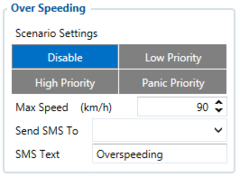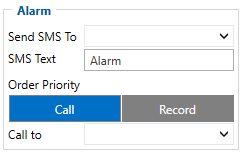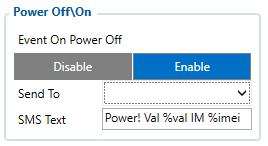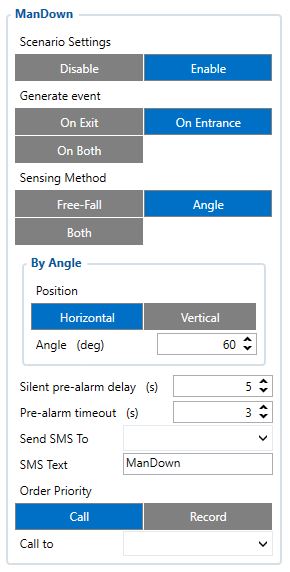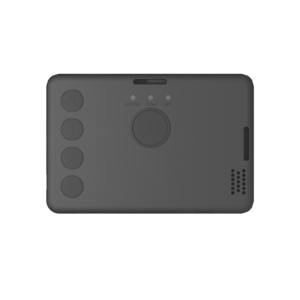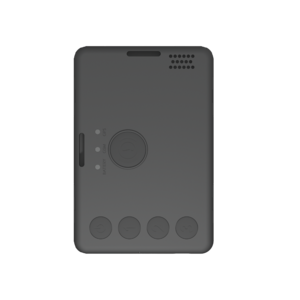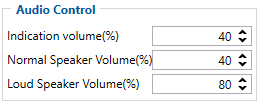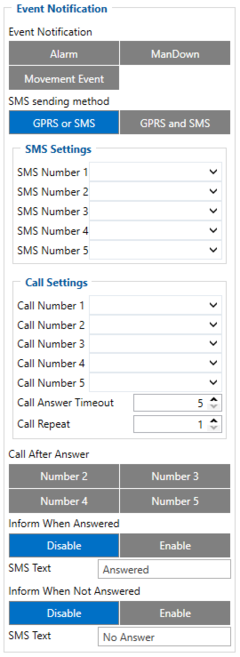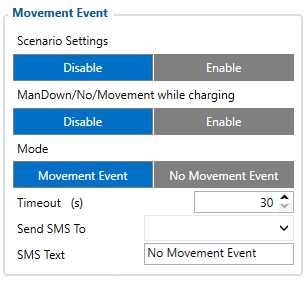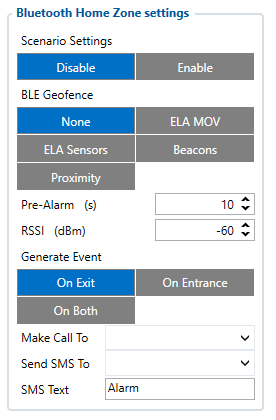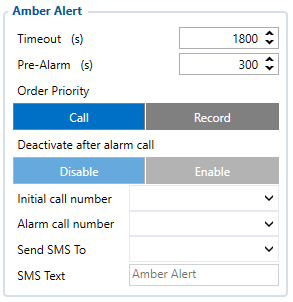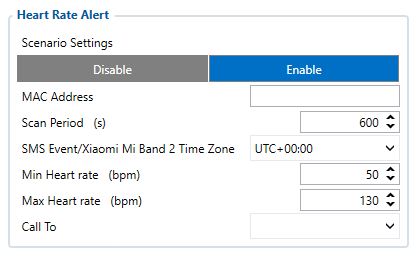From Wiki Knowledge Base | Teltonika GPS
Revision as of 10:33, 14 April 2023
Main Page > Autonomous Trackers > GH5200 > GH5200 Configuration > GH5200 Features settings
Over Speeding
| This feature is used to prevent the driver from exceeding fixed speed and inspects the driver if needed. When vehicle speed exceeds maximum configured speed value the scenario is activated, and a record is generated. Scenario is activated until speed value decreases below the set parameter value.
|
Alarm
|
This function can only be triggered by the configured button. When the alarm is triggered, an event with IO ID 236 is generated. Eventually an SMS will be sent informing user about the event. A call possibility is also available if desired number is selected near Call to parameter. In addition, users are allowed to configure event priority. Two options are available - Call where voice call comes first and Record where data transmission to servers will be prioritized over a voice call.
|
Additional Features
|
User ID feature allows users to send custom number as AVL ID 854 parameter.
|
Power Off\On
|
This functionality is for informing about manually switching device on and off. There are 2 notification options: SMS event and eventual record IO ID 390 on power.
When SMS event is enabled, then SMS will be sent to the selected phone number when a device is switched on or off. In addition, the device will be turned off when SMS will be sent successfully or after 30s trying to send it.
When a user enables Event On Power Off parameter, then the device will generate high priority record on power off with event IO ID 390 and with value “1” and “0” for power on. The record sending procedure can take up to 30s. After a successful record sending procedure device shuts down immediately. If sending fails, after 30s device will shut down anyway. This record will be sent when device will be turned on.
When Event On Power Off parameter is enabled together with SMS event, after a high priority record is created, device will try to send this record first over a GPRS connection. After a successful or failed sending procedure, device starts sending an SMS event.
|
ManDown
|
Man-Down functionality has two methods and combination of them to initiate ManDown event.
- First method FreeFall is checking for a free-fall condition. The device should be in free-fall for user defined duration and within g-force range between 0mg and user defined threshold in all three X,Y,Z axis. Duration in a free fall can determine how long device can be falling before triggering silent pre-alarm timer. This parameter can be used to determine an approximate height. As example, 450ms in theory should give approx. 1m falling before trigger, but in a reality would be recommended to use shorter duration in order to actually trigger from required height or higher. Sensitivity can be set in percentage which is calculated from 960mg. There is a possibility to cancel Mandown in Pre-Alarm state using Mandown Cancel button action, which could be configured in Keyboard settings.
- Second method only angle reads current accelerometer data each second, calculates angle between selected offset position, compares calculated angle with configured angle and if this angle exceeds configured angle, the silent pre-alarm timer is triggered. When an angle returns to normal, timers are reset and an event and its indication are canceled.
- Third combined method waits for free-fall trigger and after the device has fallen, an angle is checked. After both conditions were met, the silent pre-alarm timer is triggered. In case, if angle returns back to normal, the timers are reset and ManDown could not be generated if it wasn’t generated before that.
Timers explained:
After user-defined silent timeout ends, Man-Down Pre-Alarm indication and Pre-Alarm timeout starts. After the configured Pre-alarm time ends, event is generated. When event is generated, device can send configured SMS to one of 10 defined numbers and make a call.
|
Audio Control
|
This feature allows users to customize GH5200 volume based on their needs. 3 volume control settings are available - Indication volume, Normal Speaker Volume, Loud Speaker Volume.
|
Event Notification
|
The purpose of this function is to notify any alarm events by sending an SMS message to up to 5 receivers and to call up to 5 pre-defined numbers.
These high priority events can be configured:
- Alarm;
- ManDown;
- Movement Event.
At least one of the following has to be selected for this feature to work - Alarm, ManDown or Movement Event. In addition, at least one SMS Number or one Call Number has to be configured.
Users are allowed to configure SMS sending method. Two options are available - GPRS or SMS option which sends an SMS when GPRS fails and GPRS and SMS option which sends an SMS when GPRS fails or device sends records to the server.
Call Answer Timeout is used for indicating successful call - if voice call was answered but configured time-out has not been reached, the voice call is considered unsuccessful and if only one number is configured, the device repeats the call as many times as the value configured in Call Repeat field. However, if the call is not successful and there are other predefined numbers selected, the device continues to call other configured numbers instead of repeating voice calls to the same number.
NOTE! Some operators provide voice information when the recipient is unreachable or call is not accepted. Such voice information may last longer than the configured time. In that case, the call will be considered as accepted.
|
Movement Event
|
Movement Event scenario makes an eventual high priority record (and sends an optional SMS) when the device is stationary or in motion (depending on configured "Mode") for set Timeout.
Timeout is a configured amount of time (in seconds) after which an eventual high priority record is generated.
Movement Event mode generates a record after the start of movement whereas No Movement Event generates a record after the stop of movement.
NOTE! In case if No Movement Event is selected as Mode, then Pre Alarm Timeout is counted additionally.
When enabled, device waits for instant movement/stop detection, then waits for its own Timeout, generates a high priority eventual record and sends it.
ManDown/No/Movement while charging disables Mandown, No Movement, Movement events when device is charging.
|
Bluetooth Home Zone settings
| NOTE!
|
Bluetooth Home Zone can be tested on HomeZone scenario FW 55.00.08.Rev.319 or newer
|
Important Home Zone parameters in Bluetooth features section:
- BLE Geofence – Select to use
ELA MOV, ELA BLE advertiser Sensors, Beacons or Proximity.
- Home Zone RSSI (dBm) – Lowest Home Zone RSSI threshold before an alarm event.
Example: If Home Zone RSSI (dBm) is set to -100 and the device signal becomes worse (e.x.-101) an alarm event is generated.
- Time-Without-Beacon(s) – Time without beacon detection before violation (minimum 40 seconds)
Example: If Beacon has not been detected by the device for 60 seconds, an alarm event is generated.
Pre-Alarm: Defines how much time user has before record will be send to the server. During this time Alarm event could be disarmed.
Note: This setting also controls Proximity Pre-Alarm.
RSSI (dBm): Defines lowest RSSI signal level for BLE advertising device.
Generate Event
On Exit – Generates an event after device has left the zone.On Entrance – Generates an event after device has entered the zone.On Both – Generates an event when device has left and entered the zone.
Call to: Select a number from 10 GSM Predefined Numbers list to which alarm call will be made.
Send SMS To: Select a number from 10 GSM Predefined Numbers list to which SMS will be send.
SMS Text: Defines SMS text that will be send when Home Zone event is generated.
 Instructions on how to configure Bluetooth Home Zone functionality can be found in here. Instructions on how to configure Bluetooth Home Zone functionality can be found in here.
|
Amber Alert
| NOTE!
|
Amber Alert can be tested on FW 55.00.10.Rev.01 or newer
|
 Instructions on how to configure Amber Alert functionality can be found in here. Instructions on how to configure Amber Alert functionality can be found in here.
Important Amber Alert parameters in Features section:
Timeout: Defines time until Amber Alert alarm is processed.
Pre-Alarm: Sets the remaining time, when the pre-alarm should be triggered.
Order Priority: Defines call or record priority.
When Call is selected, device will call to defined number and creates Amber Alert record.
When Record is selected, device will create Amber Alert record and calls to defined number.
Initial call number: Select a number from 10 GSM Predefined Numbers list to which alarm call will be made.
Alarm call number: Select a number from 10 GSM Predefined Numbers list to which alarm call will be made.
Send SMS To:Selects number from 10 GSM Predefined Numbers list to which Amber Alert SMS will be send.
SMS Text:Defines SMS text that will be send when Amber Alert event will be generated.
|
Last Known Position
| NOTE!
|
Last Known Position can be tested on FW 55.00.10.Rev.01 or newer
|
This feature adds low priority record AVL ID 386 to all records.
The record shows how much time in seconds has passed since last GNSS fix.
 This feature affects Alarm, ManDown, Movement event and Amber Alert features. This feature affects Alarm, ManDown, Movement event and Amber Alert features.
If the last good coordinate at the time the record is created is older than 60 seconds, then the new high priority record AVL ID 69 will be sent immediately after GNSS fix appears. No matter how many different records have been created when there was no GNSS fix, only one high priority AVL ID 69 record will be created when GNSS fix appears.
Heart rate Alert
| NOTE!
|
Heart rate Alert feature is available on FW 55.00.21.Rev.00 or newer
|
When this feature is enabled, handheld device searches for configured Xiaomi Mi Band 2 MAC address. When the band is found, handheld device initiates connection. Once connected, it tries to authenticate with the band. If authentication succeeds, handheld queries the time set in Xiaomi Mi Band 2. When time difference between synchronized handheld and the band is more than 30 seconds, Teltonika device sets its time to band, taking into account configured time zone.
When this initial process is done, one-time heart rate measurement request is sent to Xiaomi Mi Band. Usually it takes 7 to 14 seconds for the measurement. Afterwards, at each ‘Scan Period’ (param ID 1802) a new heart rate measurement is made and saved.
If the measured heart rate is outside the configured Min/Max rates, there will be a call to a specified number and High priority record made. Order priority: call, then record sending.
| NOTE!
|
Heart rate that is within Min/Max is saved in a low priority periodic record with AVL ID 403. Otherwise it is saved in eventual high priority record with the same AVL ID: 403. They are sent according to ‘Send Period’ configured in ‘Data Acquisition’.
|
|
|
